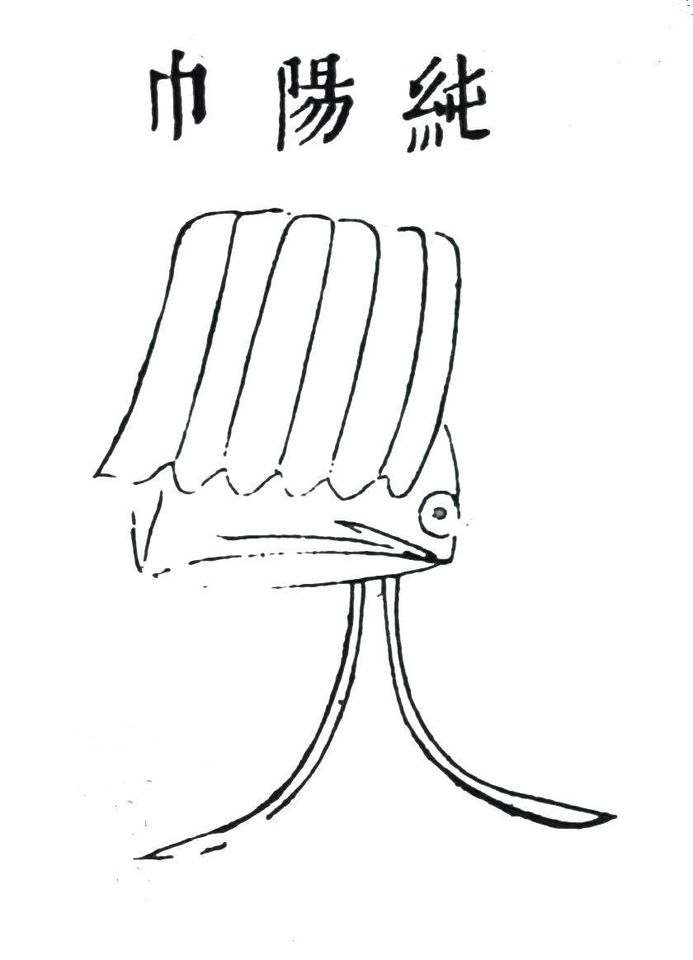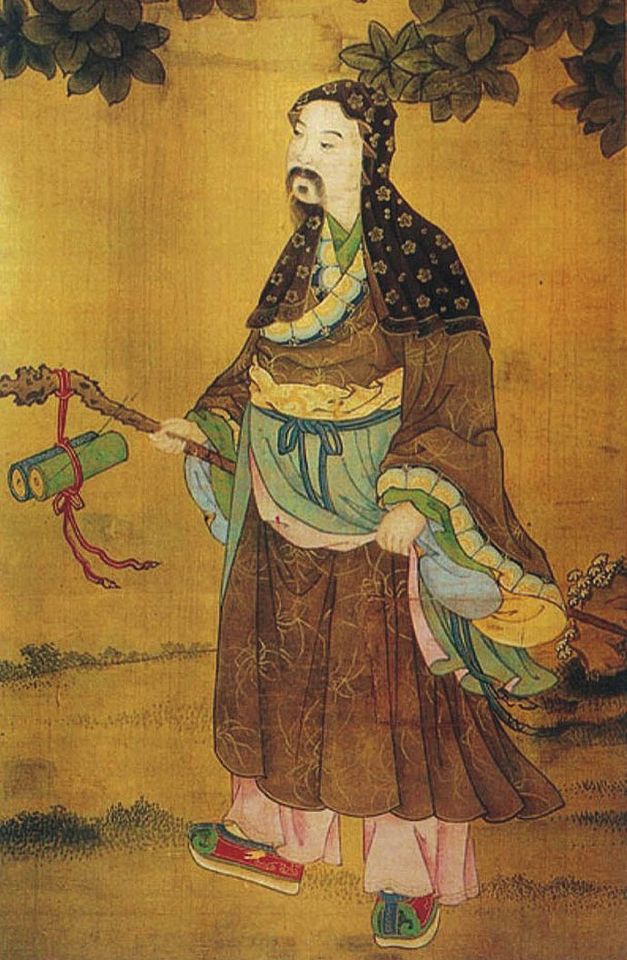The secont part will introduce more items and accessories in detail and give historical background informations.

Chún Yáng jīn – 纯阳巾 – Chun Yang Scarf
The Chúnyáng Jīn – 纯阳巾 is one of the oldest among the Nine Daoist Head Scarves and has seen a lot of changes and variations during the ages of time. In our days the Chúnyáng Jīn has a base that’s similar to the Zhuāngzi Jīn – 庄子巾 but is rectangular instead of trapezoidal. At the top of the Scarf, a flap made of fabric and with a sharp fold in the middle is attached. The fold divides the flap in two parts which hang down at the front and the backside of the Scarf and remind a little on a rooftop. Some of the sources mention that the flap is symbolizing a cloud and that’s probably also the reason why historical descriptions of the Chúnyáng Jīn often report that ruffles and folds where attached to the flap – to reinforce this cloud like look.

At the back of the base, two long sword-shaped straps, called Huì jiàn – 慧剑 are attached, symbolizing the sword of wisdom, which according to the teachings of Lü Dongbin – 吕洞宾 (daoist scholar and one of the eight imortals 796 CE-1016 CE), should cut of the three arch-desires: worrys (out of greed), anger and sexual drives…Besides the classic plain, black type of the Chúnyáng Jīn, a lot of other versions in different colors and with embroideries like the Bagua and several other patterns are available.

The first description of a Chúnyáng Jīn is to find in Wang Qi’s – 王圻 (Ming Dynasty Scholar 1530 – 1615) encyclopedia Sancai Tuhui – 三才图会 – Pictorial Compendium of the Three Realms from 1609.”Chúnyáng jīn, also called Lètiān Jīn, quite similar to the Han and Tang Scarves. The top has an cùn silk, and folds like bamboo slips and hangs behind, the Scarfe has a cloud pattern. It is said that Chúnyáng are named after an immortal (Chúnyáng Zi – 純陽子 – Master Pure-Yang is a Honorary title of Lü Dongbin – 吕洞宾), while Lètiān is named after the person (Lè Tiān – 乐天 were the characters used by Tang Dynasty poet Bai Juyi – 白居易 as pseudonym)”. The Chúnyáng Jīn is often equated with the Jiǔliáng Jīn – 九梁巾 – the Nine Beam Scarfe which is basically wrong, in fact the Chúnyáng Jīn is one of the basic forms of the Jiǔliáng Jīn.

Jiǔliáng Jīn – 九梁巾 – Nine Beam Scarf
Basically there are two variations of the Jiǔliáng Jīn, one based on the Chúnyáng Jīn – 纯阳巾 and the other on the Zhuāngzi Jīn – 庄子巾. The variation based on the Chúnyáng Jīn shows nine seams, representing the beams attached to the flap on the top of the Scarf. There are also versions where the rear side of the flap is omitted.

This version is also called Jiǔyang Jīn – 九阳巾 – Nine Yang Scarf, which is derived from the name Chúnyáng Jīn – 纯阳巾 (纯阳 – pure yang).The other variation has a extra flap attached at the front of a Zhuāngzi Jīn, which also shows the nine seams.The seams are usually underlaid with stripes of fabric to enhance the impression of the Beams.In daoism, nine is the highest number of yang and represents also heaven and the heavenly realms. That means that wearing a Jiǔliáng Jīn represents the idea of the unity between daoism and heavenly realms and that daoists are serving the heavens.
It also embodies the thought from the “Huáng Dì Yin Fu Jing – 黃帝阴符经” – Yin Convergence Scripture oft the Yellow Emperor “Contemplate the Way of Heaven and maintain the activities of Heaven, then all is done. – 观天之道,执天之行,尽矣。”One of the earliest descriptions of a Jiǔliáng Jīn – 九梁巾 is in Wang Qi’s – 王圻 (Ming Dynasty Scholar 1530 – 1615) encyclopedia Sancai Tuhui – 三才图会 – Pictorial Compendium of the Three Realms from 1609, showing a Chúnyáng Jīn with seams attached to the flap.In our days Jiǔliáng Jīn are often worn by Zheng Yi daoists from south east Asia.

Hàorán Jīn – 浩然巾 – Haoran Scarf
The Hàorán Jin, is shaped like a hood and often made of wool or other thick kinds of fabric like raw silk, cause it’s made for winter times and cold or bad weather. The Hàorán Jin is basically a rectangular piece of fabric which is sewn together at the top end, so that it forms a hood that runs out over the shoulders and forms a short cape which ends at the middle of the back or the hips.Some times a collar like piece of fabric is attached to the inside, to give the Head Scarf more hold and protection for the throat.
It is not commonly used in the south, and in nowadays even rarely seen in the north.Another version of a Hàorán Jin is the so called Fú Jīn – 幅巾 – the Width Scarf which has the tip of the hood rounded and a band of fabric attached to the front side, so it could be tied under the chin or at the back of the head if the cape is not needed, this version is often made from a lighter kind of fabric, to protect the wearer from sun and rain.This modernized form of the Hàorán Jin is more common at our days and also seen more often.The Hàorán Jīn, is named after Meng Haoran – 孟浩然 (689 – 740 CE ) an landscape and pastoral Poet of Tang Dynasty (617 – 907 CE) who was known for wearing this Head Scarf.

Other names to the Hàorán Jin are 大風帽 – Dà fēng mào – Big Hood and 雪巾 – Xuě Jīn – Snow Scarf. Historical sources on the Hàorán Jīn are:Zhu Quan’s – 朱权 (1378 – 1448 CE) “Emperor Zhidao Taiqing Jade Book” – 天皇至道太清玉册 from 1444 CE – contains an early description of a Hàorán Jīn”In black It is made of silk, with swan skin as the lining, wherever the snow is cold, it is used to protect the brain.” – “以玄色紵丝为之,以天鹅皮为里,凡雪天严寒皆用之以护脑。”And Min Yide – 闵一得 (1749 – 1836 CE) a Daoist of Qing Dynasty (1644 – 1912 CE) which writes in his book “Clear Rules and Mysteries” – 清规玄妙 “Snowy nights use Haoran.” – “雪夜用浩然。”

Tàiyáng Jīn – 太陽巾 – Sun Scarf
Tàiyáng Jīn – 太陽巾 – the Sun Scarf, a Scarf that’s worn for sun protection. The Tàiyáng Jīn is basically shaped like a Zhuāngzi Jīn on which a broad, stiff, brim is attached. The scarf has this shape, so daoists can wear there traditional Hair Bun – Fǎ jì and hairpin while wearing this Scarf.
The Tàiyáng Jīn is also one of the few daoist Scarves which is commonly not black, because of his purpose as sun protection, the Tàiyáng Jīn is made out of blue fabric and has a white lining. The Tàiyáng Jīn is very similar to the sun hats of the Ming Dynasty and probaply evolved from them, but reliable sources are very rare on this.
So, the Tàiyáng Jīn is not mentioned in Min Xiaogen’s – 閔小艮 (1758-1836 CE) book of – Clear Regulations and Mysteries – 清規玄妙說 and it first appears at Min Zhiting’s – 閔智亭 (05.05.1924 – 03.01.2004 CE), book of Taoist Rituals – 道教儀范, as one of the Nine Daoist Head Scarves – 道教九巾 – Dao Jiao Jiu Jin.

The origin of the Tàiyáng Jīn is probaply the Hubei area where he’s still very common till today.The Tàiyáng Jīn is normally not worn in religious ceremonies or events, but in occasions like farm work, harvesting tea, pilgrimages or wanderings, a Tàiyáng Jīn is very suitable for daoists.

